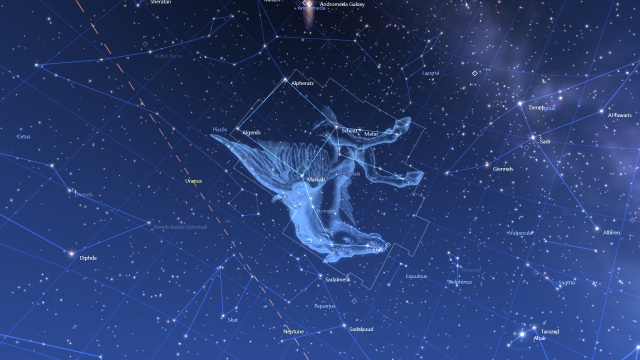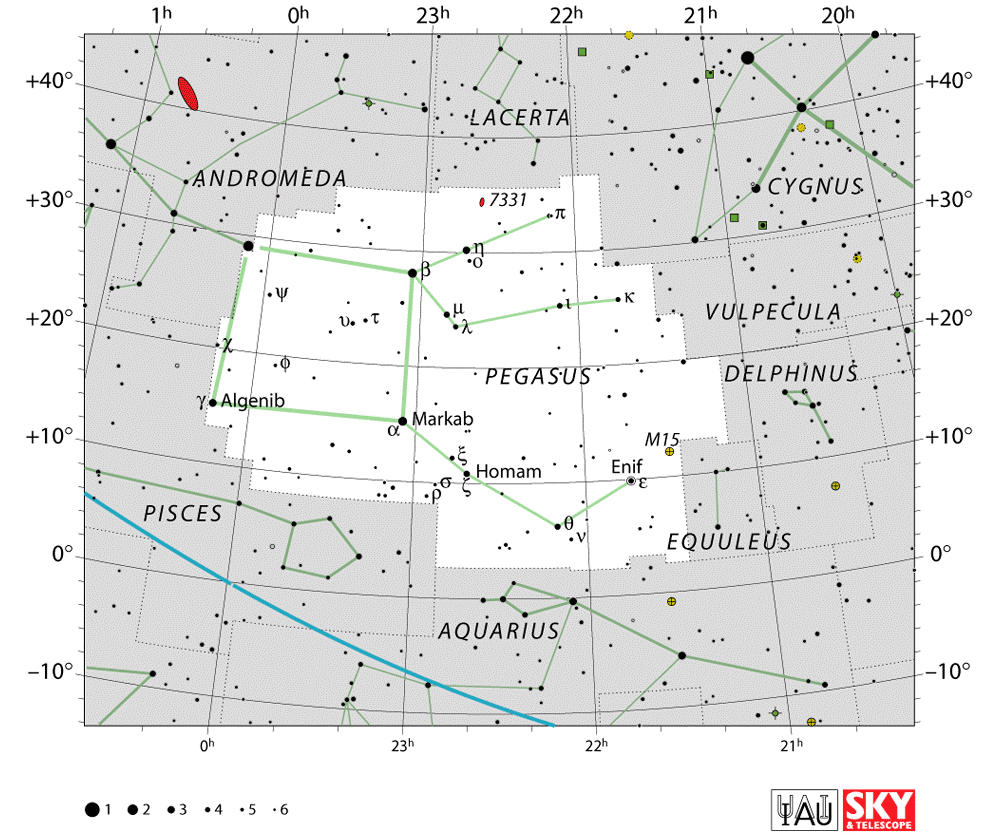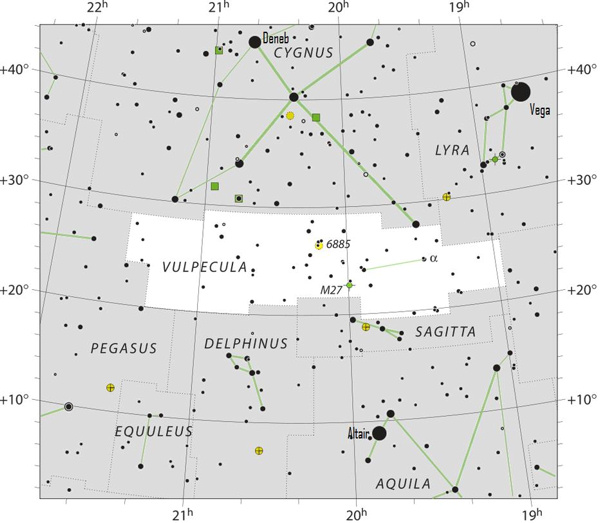
I need you guys to help me with something.
Can you find a horse in this image of the night sky?
Yeah, me neither. I’m lost. I see the Great Square of Pegasus because I know what to look for, but I still don’t see a horse.

Okay, so now I see half a horse. Where’s the rest?
Your guess is as good as mine, guys. Truth is, constellations very rarely look like what they’re named after. Constellations are more like relics of our ancient past than actual descriptors of what we see up there in the sky. But they do serve a purpose, even if that horse up there is missing his back legs.
I really find myself wondering if whoever made up Pegasus was concerned with animal rights… No animals were harmed in the making of this sky map…
Okay, yeah, never mind.
Where was I? Ah, that’s right. The purpose of the constellations, and the reason why it really doesn’t matter if they don’t look like their names say they do.

When an astronomer thinks of constellations, this is all that matters. That white carve-out of space amid the rest of the starry sky. Astronomers have imaginations, too, and in their free time I’m sure they think about the constellations the way the ancients did. I’m sure they see centaurs and eagles and queens and fish.
But all that matters, scientifically, is that white region of the sky.
Constellations are a way to map out the celestial sphere. Just as Columbus, Ohio, looks nothing like Christopher Columbus, we can hardly expect the Pegasus constellation—or any constellation for that matter—to look anything like Pegasus.
Places around the world are named after important historical figures, usually ones who are important to the people discovering the place. Similarly, places in the sky are named after mythical creatures who were important to those who first started mapping the heavens.
What does this mean? It means that the constellations are essentially like fossils of ancient civilizations’ beliefs and imaginings, just as archaeological digs turn up evidence of their material possessions and activities. Personally, I find the former much more fascinating.
Of course, we can’t exactly depend on ancient civilizations’ definitions of constellations to map out the night sky. Boundaries between constellations were shaky at best, and different cultures saw different figures in the stars. That’s why modern astronomers took forty-eight of those ancient constellations…

…And defined their boundaries themselves, making up forty new ones to fill up the gaps in the night sky.
In this image, we see Pegasus—try to think of it as a region, rather than a mythical beast—surrounded by eight other constellations.
Each one of these exists only so that astronomers can say, “The star (name) is in (constellation name).”
And that way, we know where to look for that star in the sky.
This mapping and identification system extends beyond mere stars. For example, here’s Orion, one of my all-time favorites:

Betelgeuse and Rigel are two of my favorite stars, though I’m not sure why. It’s easy to find them if I know to look in Orion. But they’re also relatively bright stars, and I don’t need Orion in order to know where to look. Instead, I use Orion to find M42, one of my favorite objects in the sky.
M42 is a nebula, a large region of gas and dust in space. Unfortunately, only more advanced imaging systems are able to pick up all the color in this image…my equipment sure can’t.
It’s also very tiny to the naked eye, and you really have to know where to look for it if you want to find it.
Telescopes with electronic drive systems can find it in the sky for you…but they still need to be programmed with where the constellations are!

So, the Orion “region,” like any other constellation, helps astronomers find objects they want to look at. And as an added bonus, their names—well, at least the original forty-eight of them—serve as insight into the minds of past civilizations.
Let me clarify one thing about constellations: They only appear to fall on the same flat plane of space above Earth’s surface. Any two stars in the same constellation might be light-years apart from one another. Some are moving at different speeds. Stars that appear bright may be faint but close to us, and stars that appear faint may be bright but just very far away.
A prime example of this is Proxima Centauri and Sirius. Sirius is the brightest star in the sky, but Proxima Centauri—a fainter star—is actually the closest to us of all the stars in the sky, only ~4.2 light-years away. Although…they’re not actually part of the same constellation…
That is to say, the constellations we know won’t be around forever—and they didn’t always look the way they do now. But that process takes more time than our lifetimes.
Constellations aren’t the only groupings of stars in the sky, although they are the only regions. There are also groupings called asterisms. Never heard the word before? I’ll bet you know what they are all the same. The Big Dipper is one. So is the Great Square of Pegasus. So is the Summer Triangle.
See? You’re familiar with them—it’s just a new name. The Big Dipper doesn’t have its own region. It has seven stars and that’s it. It’s part of the region of the Great Bear. The Great Square of Pegasus is part of Pegasus, but one of its stars—Alpheratz—is actually part of Andromeda.
And likewise…the Summer Triangle doesn’t have two stars in any one constellation.

The three largest dots above signify the three brightest stars in this cutout of the sky. They comprise the Summer Triangle. It has Altair in Aquila, Deneb in Cygnus, and Vega in Lyra.
So…what exactly is the difference between a constellation and an asterism?
A constellation is a region of the night sky, used to map out where different astronomical phenomena reside from our point of view on Earth.
An asterism is a distinctive grouping of stars, usually relatively bright, and it doesn’t matter what constellations are in the vicinity—an asterism transcends constellation boundaries.
We’ve now covered how astronomers use constellations to map the sky. But there are other ways we find our way around the heavens above, including how stars are named and the celestial sphere—and I’m going to cover those in upcoming posts.
See you around the galaxy!
It’s interesting you mention determining a star’s brightness with just the eye—that’s exactly what my girlfriend and I were doing the other night. A few weeks back, we were looking at Mars and Saturn and comparing them to Antares and Arcuturus. At that time, Mars was a little brighter than all of them (with the possible exception of Arcturus—my memory is a little hazy LOL It was clearly brighter than Saturn though.)
Friday night we looked again and Mars had obviously faded. To me, it looked about the same brightness as Saturn but my girlfriend said that Saturn appeared ever-so-slightly brighter. She was right—according to Stellarium, Mars was magnitude 0.85 and Saturn was 0.82.
Estimating the brightness of the stars and planets is something I hope to include in a new book for naked eye astronomy. Living in the suburbs of Los Angeles I don’t get the chance for much else LOL
LikeLike
It’s not exactly the topic of my expertise…I think it’s interesting that astronomers have an accurate way to determine a star’s intensity based on the apparent visual magnitude, especially because, as you mentioned, you and your girlfriend didn’t agree at first on how bright the objects were comparatively. And yet, it works!
LikeLiked by 1 person